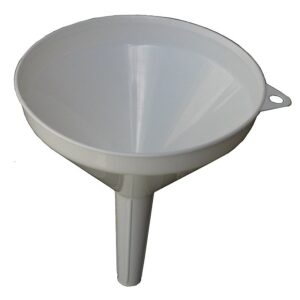Climate change, as I’ve often heard Brad Udall point out, is water change. By that, Brad means that the effect of a changing climate on people and ecosystems is most clearly felt through changes in how much water there is.

By Donovan Govan CC BY-SA 3.0, The water policy funnel
I’ve been thinking about this question a lot as I work on three related projects – one in class with UNM Water Resources Program students, and two collaborations on papers with students and colleagues – that look at the implications of declining river flows on the Lower Colorado River.
In trying to model the impact of climate change on a particular piece of the environment (perhaps the Colorado River Delta or the Salton Sea) or some human community (Las Vegas, for example, or agriculture in the Imperial Valley) we want to model the impact of a reduction in available supply of water. So we model the baseline – how much water we have now – versus some sort of climate change projection of reduced flow. Brad’s “Twentyfirst Century hot drought” paper, with Jonathan Overpeck, offers some numbers. We should expect a 20 to 30 percent reduction in flow by mid century, they found, maybe 35 – 55 percent by the end of the 21st century.
I’m not saying these are the right numbers, but they’re reasonable and citable numbers that we can plug into the models my colleagues are developing to say “What if?”
It’s not wrong to do it that way, but it avoids by simplification one of the central climate change impact questions, because in reality the impact of climate change’s “water change” won’t play out that way. Reduced flow in the Colorado River is funneled through a bunch of upstream dams and diversions, which are managed according to a set of rules.
Those rules in effect act as a funnel through which the impact of climate change flows. If climate change reduces the flow in the Colorado River by 20 percent, does everyone share in those reduction equally? Do some users see a 40 percent reduction, while others see a 10 percent reduction? Do the farmers in Imperial have a senior right, meaning they won’t lose any water? Does the environment take an even bigger hit, or do we decide the environment has suffered enough and impose bigger cuts on farms and cities?
Partly this is in part about contested interpretations of existing rules, and in part about negotiating new rules. This is where the interesting climate change questions lie for me right now – in the water policy funnel.

All things being equal, why should the upper basin continue to supply an “arbitrary” amount of water to the lower basin if the inflows are less?
Is anyone working on resetting the volumes due to each party in recognition of lower current supplies as well as much lower future supplies?
If not, what are people waiting for?
I feel like the answer to that is, the arbitrary numbers that currently exist actually give a huge advantage to the Upper Basin compared to the new numbers that would be renegotiated.
Some back of napkin math: in 1922, the Upper Basin states had roughly 1.9 million people and 8 members of Congress, while the Lower Basin states had roughly 3.8 million people and 13 members of Congress. The Lower Basin had twice the number of people and 1.6 times the strength in Congress, but each basin got an equal amount of water. Now in 2020, the Upper Basin states have roughly 12 million people and 15 members of Congress, while the Lower Basin states have roughly 50 million people and 66 members of Congress. Under the current ratio, the Lower Basin has a bit more than 4 times as many people and 5 times as much strength in Congress.
Just on gross numbers, the Lower Basin has way more people who need water compared to 1922, and way more members of Congress who can apply political pressure to get a favorable outcome compared to 1922. If the topline question of “how much water is actually legally available” gets opened up for renegotiation, then the secondary question of “how do we divide that up” is going to get opened up again as well, in a way that will be much less favorable to the Upper Basin. And that’s ignoring stuff like Native water rights in Arizona; environmental uses in the Delta/Salton Sea/etc; and the development since the 1920s of a large, nationally/globally important agriculture industry in California/Arizona – each of those issues is a credible policy reason to give the Lower Basin a larger share of the water, even though none of them was incorporated into the original Compact numbers.
Given all of this, I think the Upper Basin’s incentives point toward trying to muddle through and informally manage lower flows, instead of reopening the Compact as a whole and exposing themselves to the lion’s share of the cuts in volume. (Similarly I think the Lower Basin’s incentives point to letting the Upper Basin informally manage the flows, instead of reopening the Compact and losing the guaranteed delivery obligation.)